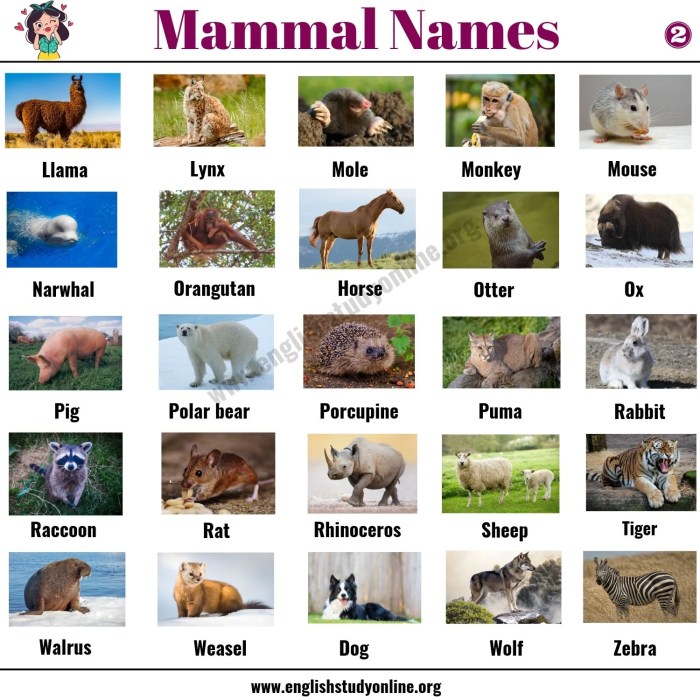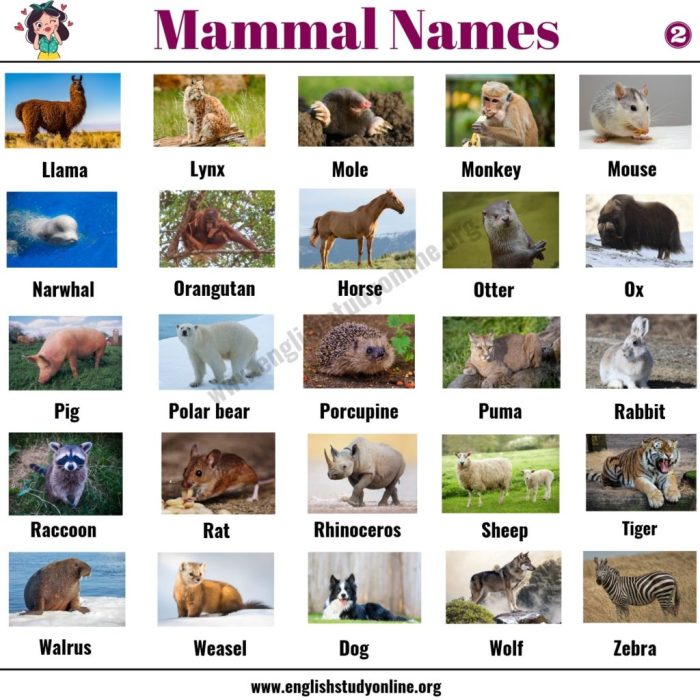Mammals ending in the letter a – Prepare to delve into the captivating world of mammals ending in the letter “a.” From the enigmatic llama to the elusive vicuña, these creatures captivate with their unique names and fascinating adaptations. Join us as we embark on an exploration of their evolutionary history, shared characteristics, and the vital roles they play in our ecosystems.
Mammals ending in “a” possess a remarkable array of physical and behavioral traits that contribute to their survival and success. Their diverse adaptations allow them to thrive in a wide range of habitats, from the towering Andes to the African savannas.
As we delve deeper, we will uncover the evolutionary advantages these unique adaptations provide.
Mammals Ending in the Letter “A”
Various mammals have names that end in the letter “a”. These names often provide insights into their physical characteristics, habitats, or behaviors.
The letter “a” is commonly found in the names of mammals that possess specific physical traits. For instance, the “a” in “llama” reflects the animal’s elongated neck and legs. Similarly, the “a” in “giraffa” (giraffe) alludes to its long neck and slender body.
Evolutionary Significance
The use of “a” in mammalian names may have evolutionary significance. Some researchers suggest that it could be a remnant of an ancient proto-language spoken by early humans. This language may have employed a suffix “-a” to denote specific characteristics or qualities.
Over time, as languages evolved, this suffix may have become incorporated into the names of mammals. Thus, the presence of “a” in mammalian names could provide a glimpse into the linguistic and evolutionary history of these species.
Common Characteristics of Mammals Ending in “A”

Mammals ending in “a” share a unique set of physical and behavioral characteristics that contribute to their survival and success in various habitats.
Physical Characteristics
These mammals typically possess elongated bodies, streamlined for efficient movement in their respective environments. Their fur coats, often dense and well-insulated, provide protection against extreme temperatures and harsh weather conditions. Additionally, many mammals ending in “a” have specialized adaptations, such as webbed feet for aquatic environments or claws for digging or climbing.
Behavioral Traits
Mammals ending in “a” exhibit diverse behavioral traits. They are often solitary or live in small groups, displaying territorial behaviors to establish and defend their home ranges. Many are nocturnal, relying on their keen senses of hearing and smell to navigate in darkness.
They exhibit complex communication systems, using vocalizations, body language, and scent marking to interact with each other.These common characteristics, including physical adaptations and behavioral traits, contribute to the survival and success of mammals ending in “a”. They enable these mammals to thrive in their respective environments, exploiting available resources and avoiding predators, ultimately ensuring the continuation of their species.
Unique Adaptations of Mammals Ending in “A”

Mammals ending in “a” exhibit a remarkable array of unique adaptations that allow them to thrive in diverse environments. These adaptations range from physical characteristics to behavioral traits and have played a crucial role in the evolutionary success of these species.
Prehensile Tails
One of the most striking adaptations found in some mammals ending in “a” is the prehensile tail. This highly specialized tail is capable of grasping and manipulating objects, providing these animals with an extra limb for locomotion, feeding, and defense.
The prehensile tail is found in primates such as spider monkeys and howler monkeys, allowing them to navigate the treetops with agility and precision.
Habitat and Distribution of Mammals Ending in “A”
Mammals ending in the letter “a” inhabit diverse habitats across the globe, ranging from lush rainforests to arid deserts. Their distribution is influenced by a combination of factors, including climate, vegetation, and availability of food and water.
Habitat Types
- Tropical Rainforests:Home to a wide variety of mammals, including gorillas, chimpanzees, and orangutans.
- Temperate Forests:Found in areas with moderate climates, supporting species like deer, bears, and wolves.
- Grasslands:Vast open areas inhabited by mammals like zebras, wildebeests, and lions.
- Deserts:Arid regions with sparse vegetation, supporting mammals adapted to extreme temperatures, such as camels and jerboas.
- Polar Regions:Cold environments inhabited by mammals like polar bears, walruses, and seals.
Factors Influencing Distribution
The distribution of mammals ending in “a” is influenced by several factors:
- Climate:Temperature, precipitation, and humidity play a significant role in determining the suitability of a habitat for a particular species.
- Vegetation:The type and availability of vegetation provide food and shelter for mammals.
- Food Availability:The presence of adequate food sources is essential for the survival and reproduction of mammals.
- Water Availability:Access to water is crucial for all mammals, especially in arid regions.
- Competition:The presence of other species can influence the distribution of mammals through competition for resources.
Conservation Status and Threats
Many mammals ending in “a” are facing threats to their survival, including habitat loss, poaching, and climate change.
- Habitat Loss:Deforestation, urbanization, and agricultural expansion are leading to the destruction of natural habitats.
- Poaching:Some mammals are illegally hunted for their meat, fur, or other body parts.
- Climate Change:Rising temperatures and altered precipitation patterns are affecting the distribution and availability of resources for many mammals.
Conservation efforts are essential to protect these mammals and their habitats. Measures include establishing protected areas, implementing sustainable land management practices, and raising awareness about the importance of wildlife conservation.
Ecological Roles of Mammals Ending in “A”

Mammals ending in “a” play diverse ecological roles, contributing significantly to the functioning of their ecosystems. These mammals occupy various niches and perform essential functions that maintain ecosystem balance and stability.Their ecological roles include:
Prey Species
Many mammals ending in “a” are herbivores or omnivores, serving as prey for carnivorous species. This helps regulate predator populations and maintain a balanced food web.
Seed Dispersal
Some mammals ending in “a” consume fruits and disperse their seeds through their droppings. This facilitates plant reproduction and contributes to the regeneration of forests and other plant communities.
Nutrient Cycling
Mammals ending in “a” contribute to nutrient cycling by consuming vegetation and excreting waste products that decompose and release nutrients back into the soil.
Pollination
Certain mammals ending in “a”, such as bats, play a crucial role in pollination. They feed on nectar and pollen, aiding in the reproduction of flowering plants and ensuring genetic diversity.
Ecosystem Engineers
Some mammals ending in “a” modify their habitats in ways that benefit other species. For example, beavers build dams that create wetlands, providing habitat for a variety of aquatic and terrestrial organisms.The decline or loss of mammals ending in “a” can have significant impacts on their ecosystems.
For instance, the loss of herbivores can lead to an overabundance of vegetation, disrupting ecosystem dynamics and reducing biodiversity. Similarly, the loss of seed dispersers can hinder plant reproduction and limit the regeneration of forests. Therefore, conserving these mammals is crucial for maintaining the health and balance of their ecosystems.
Mammals with names ending in the letter “a” include the llama, alpaca, and zebra. These animals are found in various regions of the world, but if you’re looking for the ideal place to live, you may want to consider a location that offers a balance of natural beauty, cultural attractions, and economic opportunities.
Check out the ideal place to live crossword to find out which destinations meet these criteria and are home to a variety of mammals, including those ending in the letter “a”.
Cultural Significance of Mammals Ending in “A”: Mammals Ending In The Letter A

Mammals ending in “a” hold significant cultural value for various societies worldwide. These mammals are often associated with specific beliefs, practices, and traditions, influencing their conservation and management.
One notable example is the cow( Bos taurus), which holds immense cultural significance in Hinduism. In India, cows are considered sacred and are revered as a symbol of motherhood, fertility, and prosperity. This cultural belief has led to the protection and conservation of cows, with many Hindus abstaining from consuming beef.
Mythology and Folklore
Mammals ending in “a” also feature prominently in mythology and folklore. The puma( Puma concolor) is an important figure in the mythology of the indigenous peoples of the Americas. In Inca mythology, the puma is associated with strength, courage, and hunting prowess, and is considered a guardian spirit.
Symbolism and Art
These mammals have been used as symbols and motifs in art and literature. The giraffe( Giraffa camelopardalis) is often depicted in African art as a symbol of grace, elegance, and longevity. In Western art, the gazelle( Gazellaspp.) represents speed, agility, and beauty.
Conservation and Management, Mammals ending in the letter a
Cultural beliefs and practices can significantly influence the conservation and management of mammals ending in “a.” For instance, the cultural reverence for cows in Hinduism has led to the establishment of cow sanctuaries and the promotion of cow welfare in India.
Conversely, the association of the puma with hunting in Inca mythology has contributed to its conservation as a symbol of wilderness and predator protection.
User Queries
Why do these mammals have names that end in “a”?
The reasons for the “a” ending in their names vary depending on the species. In some cases, it may be related to their evolutionary history or the language of their native region.
What are some common physical characteristics shared by mammals ending in “a”?
Many mammals ending in “a” have slender bodies, long necks, and agile limbs. These features often aid in their movement and survival in their respective habitats.
How do these mammals contribute to the functioning of their ecosystems?
Mammals ending in “a” play various ecological roles. They can be herbivores, carnivores, or omnivores, contributing to the balance of their ecosystems. Additionally, some species are important seed dispersers or prey for other animals.